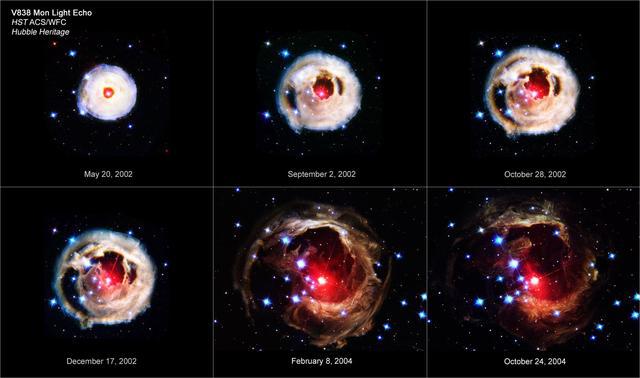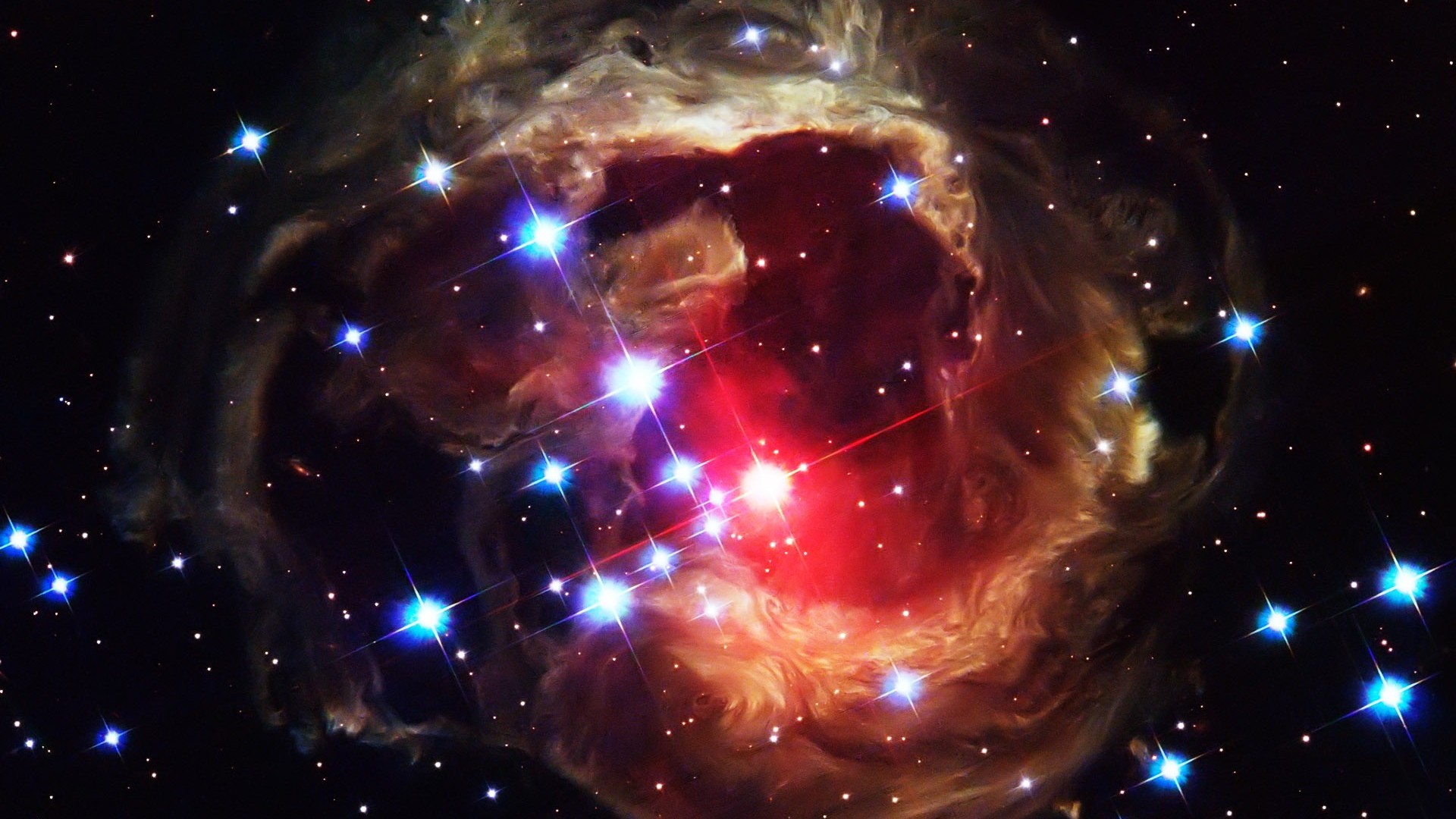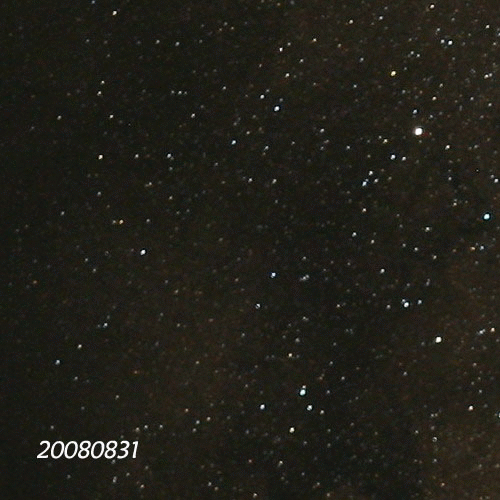亮红新星天蝎座V1309是在2008年由孙国佑(本站站长)、高兴老师以及日本天文爱好者西山浩一,椛岛富士夫,樱井幸夫共同发现的一颗银河系新星。是本人巡天生涯最重要的天文发现之一。
目前银河系内已发现的亮红新星候选体仅4颗,分别为1994年发现的V4332 Sgr,2002年发现的V838 Mon、2008年发现的V1309 Sco(全球目前为止唯一确认的一例相接双星并合事件,这个发现揭示了亮红新星的本质,V1309 SCO在双星演化研究中有着举足轻重的地位。)和2013年发现的 OGLE-2002-BLG-360。
著名的麒麟座V838很可能也是一个亮红新星(*)。麒麟座V838在爆发后演化图景,由哈勃望远镜观测
什么是亮红新星?
直到2006年,人类才真正确认了一次双星合并事件。利克天文台(Lick Observatory)超新星搜寻项目在距地球6000万光年的M85星系中发现了M85 OT2006-1的爆发,加州大学伯克利分校和加州理工的天文学家随后进行了详尽分析,发现这次爆发来源于两个低质量双星的合并,不同于之前其它所知道的新星爆发。但因此次爆发前的监测信息不足,所以,我们对于合并之前的双星系统十分缺乏了解。在这一年,天文学家们根据观测所得,为双星合并所形成的新星赋予了一个名字:“亮红新星”(luminous red novae)。
真正帮助天文学家解开“红新星”之谜的钥匙,藏在天蝎座V1309之中。这个系统最早是被中国和日本的天文爱好者发现的,他们随后将相关信息提交给了国际天文联合会的天体变源监测组织。然而,天蝎座V1309的详尽数据来自一个名为Optical Gravitational Lensing Experiment(简写为OGLE;光学引力透镜实验)的巡天项目。该项目由波兰华沙大学的天文学家于2001年正式启动,初衷是对大面积天区进行监测,希望寻找亮度发生变化的天体源,发现引力透镜现象,从而检验一些最初被认为可能构成暗物质的天体,比如黑洞。天蝎座V1309所在的位置刚好处于OGLE的监测天区之内,所以天文学家得到了其在爆发前直至爆发后的、长时间范围的大量观测数据。之后的数据分析不仅仅确认了这是一个“红新星”系统(双星合并后的系统),还为我们提供了更为重要的信息,即这个双星系统在合并之前是如何随时间演化的。
正是在天蝎座V1309系统合并前的观测数据以及建模基础之上,莫尔纳教授等人对KIC 9832227的系统演化做出了判断,预测这两颗恒星“亲密接触”并最终合并,将发生在2021年9月-2022年9月间(最新研究表明这是个误判)。
IAU8972号公报
Circular No. 8972
Central Bureau for Astronomical Telegrams
INTERNATIONAL ASTRONOMICAL UNION
Mailstop 18, Smithsonian Astrophysical Observatory, Cambridge, MA 02138, U.S.A.
IAUSUBS@CFA.HARVARD.EDU or FAX 617-495-7231 (subscriptions)
CBAT@CFA.HARVARD.EDU (science)
URL http://www.cfa.harvard.edu/iau/cbat.html ISSN 0081-0304
Phone 617-495-7440/7244/7444 (for emergency use only)
V1309 SCORPII = NOVA SCORPII 2008
S. Nakano, Sumoto, Japan, reports the discovery by K.
Nishiyama (Kurume, Fukuoka-ken) and F. Kabashima (Miyaki-cho, Saga-
ken) of a bright star (mag 9.5) on unfiltered CCD images obtained
on Sept. 2.4594 UT with a 0.40-m f/9.8 reflector, the presumed nova
being located at R.A. = 17h57m32s.93 +/- 0s.01, Decl. =
-30o43’10”.1 +/- 0″.1 (equinox 2000.0). Nothing is visible at this
position on their unfiltered CCD frames taken on Aug. 20.476
(limiting mag 12.8) and 21.470 (limiting mag 12.1) using a patrol
camera (+ 105-mm-f.l. f/5.6 lens). They note nearby USNO-B1.0-
catalogue stars at position end figures 33s.221, 10″.56 (red mag
12.7) and 33s.015, 10″.39 (red mag 14.8). Additional independent
discoveries also were reported from survey images obtained with
digital cameras and telephoto lenses by Y. Sakurai (Mito, Ibaraki-
ken, Japan; via Nakano; nova at mag 9.7 on Sept. 3.4) and by Guoyou
Sun (Qufu, Shandong, China) and Xing Gao (Urumqi, Xinjiang, China)
in the course of the Xingming Observatory Nova Survey (mag
approximately 10.5 on Sept. 2.6). Following posting on the CBAT
unconfirmed-objects webpage, several other observers sent
observations of V1309 Sco that were included with additional
discovery details on CBET 1496. Additional selected magnitudes
(mostly from unfiltered CCD images) for the nova: 1958 Apr. 18,
[19.0 (red Palomar Sky Survey, via C. Jacques and E. Pimentel, Belo
Horizonte, Brazil); 2008 July 30, [12 (Sakurai); Aug. 14, 20, 21,
and 30, [13.5: (Sun and Gao); 30.783, [14.5 (D. Chekhovich, S.
Korotkiy, and T. Kryachko, Karachay-Cherkessia, Russia); 31, [13.5:
(Sun and Gao); Sept. 2.735, 10.5 (Chekhovich et al.); 3.512, 9.0
(Nishiyama and Kabashima); 4.489, 8.3 (Nishiyama and Kabashima);
5.483, 7.1 (Nishiyama and Kabashima). N. N. Samus, Institute of
Astronomy, Moscow, informs us that this nova has been assigned the
designation V1309 Sco.
H. Naito, Nishi-Harima Astronomical Observatory, reports that
low-resolution spectra of V1309 Sco were taken on Sept. 3.49 and
4.47 UT by M. Fujii (Ibara, Okayama, Japan, 0.28-m reflector; range
400-800 nm, resolution R about 500) and on Sept. 5.47 by Naito with
the 2.0-m NAYUTA telescope (+ MALLS; range 410-670 nm, R about 1200).
The spectra show a smooth continuum with some absorption lines and
strong Balmer emission lines, which indicate that this object is
indeed a classical nova. The expansion velocities derived from the
FWHM of H_alpha are somewhat slow (670 km/s on Sept. 3.49, 670 km/s
on Sept. 4.47, and 470 km/s on Sept. 5.47). The spectrum also
shows an interstellar Na D absorption line (EW = 0.6 nm). The
ratios of H_alpha to H_beta are 10 on Sept. 4.47 and 6.7 on Sept.
5.47.
(C) Copyright 2008 CBAT
2008 September 6 (8972) Daniel W. E. Green
————————————————-
AAVSO公报
https://www.aavso.org/aavso-alert-notice-383
Nova Scorpii 2008
September 6, 2008
Event: Novain Scorpius
Discovered By: K. Nishiyama (Kurume, Fukuoka-ken, Japan) and F. Kabashima
Discovery Date: 2008 September 02.4594 UTC (JD 2454711.9594)
Discovery Magnitude: m = 9.5 (unfiltered)
Position: RA = 17h 57m 32.93s , Dec = -30d 43m 10.1s (from Nishiyama
Charts: Finder charts for this object may be plotted by entering the
coordinates above into VSP: http://www.aavso.org/observing/charts/vsp/
The sequence was prepared by M. Morel.
Notes: This object was announced as a nova in IAU Circular 8972 (Daniel
W.E. Green, editor).
low-resolution spectra by M. Fujii (Ibara, Okayama, Japan) and H. Naito
(Nishi-Harima Astron. Obs.) on Sept 3.49 and Sept 5.47 respectively.
This object has been given the formal variable star designation
“V1309 Sco”.
and confirmation.
The following observations have been submitted to the AAVSO since the
issuance of AAVSO Special Notice #124 (2008 September 03): JD
2454713.4167, m(vis) = 9.3 (A. Amorim, Florianopolis, Brazil);
2454713.51944, m(vis) = 9.0 (L. Shotter, Uniontown, PA, United States);
2454714.03056, m(unfiltered) = 8.7 (R.J. Kaufman, Bright, Victoria,
Australia); 2454714.54167, m(vis) = 8.2 (L. Shotter); 2454714.99097,
m(unfiltered) = 8.0 (R.J. Kaufman); 2454715.5590, m(vis) = 8.4 (G.
Beltran, Cochabamba, Bolivia); and 2454715.94028, m(unfiltered) = 8.0
(R.J. Kaufman).
Thanks to all observers who have submitted observations thus far.
Continued observations are strongly encouraged throughout this nova
outburst.
or the AUID “000-BFT-812”.
may also be used.
Congratulations to the discoverers!
Clear skies, and good observing,
Matthew Templeton
AAVSO
———————————————–
相关文章 (论文):
1,五年后,我们将见证双星合并
http://www.kepuchina.cn/qykj/hkht/201701/t20170124_65726.shtml
2,维基百科 V1309 Scorpii
https://en.wikipedia.org/wiki/V1309_Scorpii
3,Post-outburst spectra of a stellar-merger remnant of V1309 Scorpii: from a twin of V838 Monocerotis to a clone of V4332 Sagittarii.
https://arxiv.org/abs/1504.03421v2
4,The peculiar nova V1309 Scorpii/nova Scorpii 2008/A candidate twin of V838 Monocerotis.
http://arxiv.org/abs/1004.3600
*亮红新星(luminous red novae),也叫发光红新星,比较新的概念,暂时无统一中文译名,个人倾向于亮红新星这个名称。




